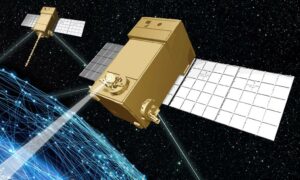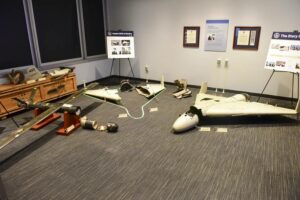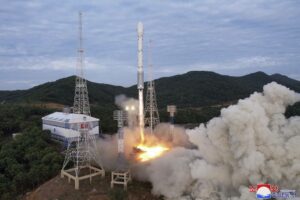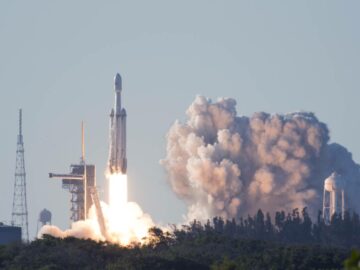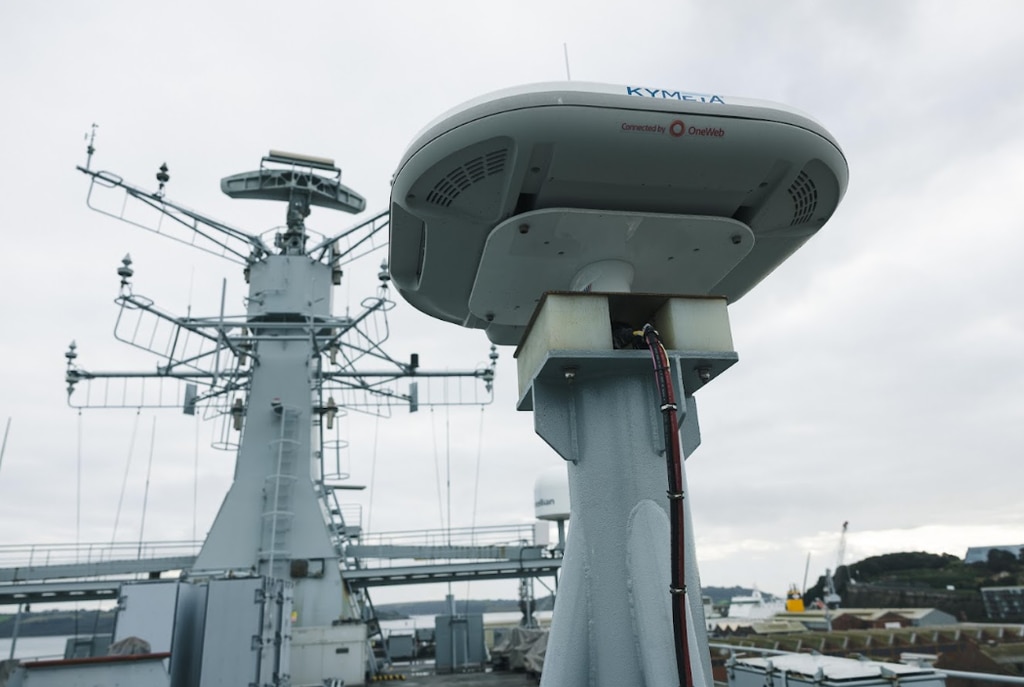
LONDON — With SpaceX’s Starlink constellation dominating the space-based communications market, longstanding satellite operators are positioning themselves to compete with the billionaire-owned company — particularly when it comes to military and government services.
SpaceX, with its 5,000-satellite Starlink fleet, has a hedge on the satellite communication market, but executives at U.K.-based OneWeb and Luxembourg-based Intelsat told C4ISRNET this week during the DSEI conference here they see opportunities to join the behemoth in meeting increasing connectivity demands.
Chris Moore, OneWeb’s vice president for defence and security, said in a Sept. 12 interview demand for these services means that other providers likely won’t be waiting in the wings much longer.
“We’ve got a supply problem — it’s a good problem to have,” he said. “There’s plenty of room for us and Starlink in terms of meeting the world’s connectivity problems in the short term. And of course, others are going to be coming online.”
SpaceX’s success with Starlink has also pushed its competitors to refocus and make new investments, according to Rory Welch, vice president of global government and satellite services at Intelsat.
“It’s forced a lot of the traditional providers like Intelsat to up our game,” Welch said in an interview. “And we are. We’re making big investments in our future network.”
Starlink’s preeminence in the satellite internet services market has put SpaceX in the spotlight in recent weeks following the release of a biography of the company’s billionaire founder Elon Musk. The book, written by journalist Walter Isaacson, claims that Musk secretly turned off Starlink services to prevent Ukraine from targeting Russian naval vessels in Stevastopol, the largest city in Crimea.
Musk has since stated that he didn’t turn off Starlink, but had in fact never activated the service in the region over concerns about how Russia might respond to an attack.
While SpaceX wasn’t under a military contract at that time, the U.S. Defense Department has since formalized an agreement with the company for Starlink services, though officials have not confirmed details on the specifics of that deal.
The scenario has raised concerns among military leaders that commercial companies like SpaceX could refuse services in a time of conflict and underlines the pitfalls of relying on a single commercial provider for such a vital capability. Air Force Secretary Frank Kendall said this week at the Air Force Association’s Air, Space and Cyber conference in National Harbor, Md., that without assurances that a commercial company will provide capabilities when needed, “they’re not something we can rely on in wartime.”
Global coverage
For OneWeb and Intelsat, the path toward competing with industry giant SpaceX has included a certain degree of rebuilding. Both companies declared bankruptcy in 2020 and underwent a financial restructuring.
Since emerging from bankruptcy, OneWeb has launched hundreds of satellites to low Earth orbit — about 1,200 miles (2,000 km) above the planet’s surface. That includes its latest batch in May, which brought its constellation to 634 spacecraft and helped it achieve global coverage in orbit. By early next year, it expects to have fully rolled out its ground infrastructure, which will close the loop for full global coverage.
During DSEI, OneWeb announced that Britain’s Royal Fleet Auxiliary ship, Argus, had connected to its LEO constellation — marking the first time a military vessel deployed its SATCOM services. It also revealed the release of a portable, lightweight terminal that will bring broadband connectivity to users in remote areas. The equipment, which can fold into a large backpack, is ideal for military operators and rescue crews working in hard-to-reach areas with difficult terrain.
OneWeb’s fleet is much smaller than Starlink’s, but Moore said the company has a narrower customer base that includes high-end industries like telecommunications and energy as well as military and other government agencies. While it may compete with Starlink in those areas, it’s less focused on the mass consumer market.
The company’s impending merger with French SATCOM provider Eutelsat — which is set to close at the end of this month — will also allow it expand its coverage to new orbits, offering future customers a more diverse capability.
Eutelsat operates a fleet of satellites in geostationary orbit, about 22,000 miles (35,000 km) above Earth. While LEO constellations like Starlink can provide a more responsive service to a broad set of consumers, GEO-based systems offer more power and capacity to support higher-end missions, such as machine-to-machine teaming for uncrewed military aircraft.
Having that combination, Moore said, differentiates the company.
OneWeb is also in the process of designing its next generation of LEO satellites, which could be operating as soon as 2025. The spacecraft will replace older systems in the constellation, bring more capacity and will be upgradeable through software modifications. The second-generation, or Gen 2, satellites will also be built with both military and commercial requirements in mind, Moore said.
“Where Gen 1 was very much a commercial platform and a commercial architecture with some military applications on top, we’re designing Gen2 to be dual-use from the outset,” he said. “We’re in lots of conversations with a few governments about what that looks like.”
Beyond low Earth orbit
Intelsat has also been working to bolster its position in the SATCOM market. A central feature of that work was establishing its global government and satellite services business in January, which Welch leads.
The new business unit is focused on growing the company’s work with international allies. That includes not only the traditional Five Eyes partners, but other countries in Eastern Europe, Scandinavia and the Asia-Pacific region who worry about security threats from Russia or China.
“When they spend more on defense, typically there’s a drag along with them spending more on space,” Welch said. “And these are countries that tend to operate in a more austere environment with less infrastructure or where they’re doing more deployments outside of their individual countries, a lot more need for beyond-line-of-sight communications.”
Along with offering Intelsat’s core SATCOM services, the global business unit provides assistance to customers as they design, build, launch and operate their satellites.
The company is also looking to expand its global, GEO-based satellite network to include operations in medium Earth orbit, between GEO and LEO. Welch said Intelsat considered whether to develop its own LEO constellation but determined that MEO “made better sense” from a cost and complexity standpoint. The company is in the early stages of designing those satellites.
Intelsat is establishing new partnerships with LEO operators and is also producing a new line of software-defined GEO satellites that can reroute traffic and adjust beams to ensure full coverage across orbits.
“We’re really focused on the multi-layer elements of our network because we really think that it’s not just one — it’s not just LEO or GEO or MEO,” Welch said. “We’re going to compete with Starlink and other LEO operators because we’re a commercial company, but I think it’s more about what we can do as a multi-orbit constellation.”
Courtney Albon is C4ISRNET’s space and emerging technology reporter. She has covered the U.S. military since 2012, with a focus on the Air Force and Space Force. She has reported on some of the Defense Department’s most significant acquisition, budget and policy challenges.
- SEO Powered Content & PR Distribution. Get Amplified Today.
- PlatoData.Network Vertical Generative Ai. Empower Yourself. Access Here.
- PlatoAiStream. Web3 Intelligence. Knowledge Amplified. Access Here.
- PlatoESG. Automotive / EVs, Carbon, CleanTech, Energy, Environment, Solar, Waste Management. Access Here.
- PlatoHealth. Biotech and Clinical Trials Intelligence. Access Here.
- ChartPrime. Elevate your Trading Game with ChartPrime. Access Here.
- BlockOffsets. Modernizing Environmental Offset Ownership. Access Here.
- Source: https://www.defensenews.com/battlefield-tech/space/2023/09/15/how-two-satcom-companies-are-responding-to-starlinks-dominance/
- :has
- :is
- :not
- :where
- $UP
- 000
- 1
- 10
- 12
- 200
- 2012
- 2025
- 22
- 70
- a
- About
- above
- According
- Achieve
- acquisition
- across
- activated
- adjust
- agencies
- Agreement
- AIR
- Air Force
- aircraft
- allow
- along
- also
- among
- an
- and
- announced
- applications
- architecture
- ARE
- areas
- AS
- Assistance
- At
- attack
- Bankruptcy
- base
- BE
- because
- been
- behemoth
- Better
- between
- Big
- billionaire
- bolster
- book
- both
- bring
- broad
- broadband
- brought
- budget
- build
- built
- business
- but
- by
- CAN
- capabilities
- capability
- Capacity
- central
- certain
- challenges
- China
- City
- claims
- Close
- combination
- comes
- coming
- commercial
- Communication
- Communications
- Companies
- company
- Company’s
- compete
- competing
- competitors
- complexity
- Concerns
- Conference
- CONFIRMED
- conflict
- connected
- Connectivity
- connectivity problems
- considered
- consumer
- consumer market
- Consumers
- contract
- conversations
- Core
- Cost
- could
- countries
- course
- coverage
- covered
- customer
- customer base
- Customers
- cyber
- deal
- defence
- Defense
- Defense Department
- Degree
- Demand
- demands
- Department
- deployed
- deployments
- Design
- designing
- details
- determined
- develop
- difficult
- diverse
- do
- doing
- Dominance
- during
- Early
- earth
- eastern
- eastern europe
- elements
- Elon
- Elon Musk
- emerging
- Emerging Technology
- end
- energy
- ensure
- Environment
- equipment
- establishing
- Europe
- executives
- Expand
- expects
- Eyes
- fact
- Feature
- few
- financial
- First
- first time
- five
- FLEET
- Focus
- focused
- following
- For
- Force
- founder
- frank
- Frank Kendall
- French
- from
- full
- fully
- future
- game
- Gen
- generation
- giant
- Global
- global business
- going
- good
- got
- Government
- government agencies
- Governments
- Ground
- Growing
- had
- harbor
- Have
- he
- hedge
- helped
- here
- High-End
- How
- HTTPS
- Hundreds
- i
- ideal
- images
- in
- include
- included
- includes
- increasing
- individual
- industries
- industry
- Infrastructure
- International
- Internet
- Interview
- into
- Investments
- IT
- ITS
- January
- join
- journalist
- just
- just one
- Kendall
- large
- largest
- latest
- launch
- launched
- leaders
- Leads
- LEO
- less
- lightweight
- like
- likely
- Line
- longer
- longstanding
- looking
- LOOKS
- Lot
- Low
- make
- Making
- Market
- marking
- Mass
- May..
- means
- medium
- meeting
- Merger
- might
- Military
- Military Applications
- military contract
- mind
- missions
- Modifications
- Month
- more
- most
- much
- Musk
- National
- Need
- needed
- network
- never
- New
- next
- of
- off
- offer
- offering
- officials
- older
- on
- ONE
- online
- only
- operate
- operates
- operating
- Operations
- operators
- opportunities
- or
- Orbit
- Other
- Others
- our
- out
- outside
- over
- own
- particularly
- partners
- partnerships
- path
- platform
- plato
- Plato Data Intelligence
- PlatoData
- Plenty
- policy
- portable
- position
- positioning
- power
- president
- prevent
- Problem
- problems
- process
- producing
- provide
- provider
- providers
- provides
- pushed
- put
- raised
- really
- rebuilding
- recent
- region
- release
- rely
- relying
- remote
- replace
- Reported
- reporter
- Requirements
- rescue
- Respond
- responding
- responsive
- restructuring
- Revealed
- Rolled
- Room
- rory
- royal
- Russia
- russian
- s
- Said
- satellite
- satellites
- scenario
- secretary
- security
- Security threats
- see
- sept
- service
- Services
- set
- she
- Short
- significant
- since
- single
- smaller
- Software
- some
- something
- Soon
- Space
- Space Force
- space-based
- spacecraft
- SpaceX
- specifics
- spend
- Spending
- Spotlight
- stages
- standpoint
- starlink
- stated
- success
- such
- supply
- support
- Surface
- Systems
- targeting
- Technology
- telecommunications
- term
- Terminal
- terms
- than
- that
- The
- their
- Them
- themselves
- These
- they
- think
- this
- this week
- those
- though?
- threats
- Through
- time
- to
- told
- top
- toward
- traditional
- traffic
- TURN
- Turned
- two
- typically
- u.s.
- Ukraine
- under
- underwent
- unit
- us
- users
- very
- Vessel
- vessels
- vice
- Vice President
- vital
- Waiting
- was
- we
- week
- WELL
- What
- when
- whether
- which
- while
- WHO
- will
- with
- without
- Work
- working
- world’s
- worry
- written
- year
- zephyrnet



